2.The production process of ergothioneine
3.Mechanism of action of ergothioneine
- A.OCTN1 transporter
- B.anti-oxidation
- C.Anti-inflammation and other chronic diseases
4.Ergothioneine compared to other antioxidant products
- A.Ergothioneine VS Coenzyme Q10
- B.Ergothioneine VS Idebenone
5.Application cases of ergothioneine
- A.Ergothioneine VS Coenzyme Q10
- B.Ergothioneine VS Idebenone
- C.Inhibition of tyrosinase activity
- Effect on the relative content of melanin
- Product Specifications
Product name: Ergothioneine
Other names: EGT
Chemical formula: C9H15N3O2S
Appearance: white powder
Specifications: 99%
CAS number: 497-30-3
Solubility: soluble in water
- The production process of ergothioneine
Step 1: Inoculate Hericium erinaceus mycelium slant strain into the liquid seed medium and culture it to obtain a seed liquid;
Step 2: Inoculate the obtained seed liquid into the fermentation medium for fermentation and add precursor substances Culture, judge the fermentation to the fermentation endpoint by pH, and obtain the fermentation liquid;
Step 3: After the fermentation is completed, add enzyme, enzymolyze to the endpoint, raise the temperature to inactivate the enzyme, and extract the ergothioneine in the mycelium cells to the extracellular in fermentation broth.
- Mechanism of action of ergothioneine
Ergothioneine has coenzyme-like properties and has been proven to accumulate at high concentrations in a variety of cells and tissues in the human body. It is most abundant in red blood cells, bone marrow, liver, kidneys, and the lens and cornea of the eye. As a powerful antioxidant, its antioxidant function is mainly reflected in delaying the aging rate of human cells. When applied externally to the skin, it can increase the activity of skin cells; prevent photoaging of the skin; inhibit the activity of melanocytes and the glycation of skin proteins. reaction, thereby achieving the effect of reducing melanin production and brightening the skin.
A.OCTN1 transporter
The movement of ergothioneine in the body depends on a special transporter OCTN1 (organic cation transporter N1, the product of the SLC22A4 gene). OCTN1 is present in keratinocytes and melanocytes and has a high affinity for ergothioneine. , so skin tissues and cells can easily accept, absorb, and make full use of ergothioneine. Through OCTN1 present on the cell membrane and mitochondrial membrane, ergothioneine is transported to the mitochondria, the main "focus" of free radical production in cells, protecting mitochondria from oxidative damage while directly scavenging reactive oxygen free radicals to achieve the purpose of delaying the human body's The ultimate goal of cellular senescence.

B.anti-oxidation
Fibroblasts are the most common cells in connective tissue. They have strong functional activities and can secrete structural proteins that constitute the extracellular matrix. They are closely related to the aging process of the skin. Ergothioneine protects human fibroblasts and improves their viability by reducing the degradation of matrix metalloproteinase-1 (MMP-1) and increasing the production of type I collagen; inhibiting reactive oxygen species caused by UVA in fibroblasts Generation of free radicals, activation of transcription factor AP-1; and upregulation of Nrf2 factor in fibroblasts (a basic leucine zipper protein, which serves as a conductor of oxidative and electrophilic stress responses and inhibits genomic instability) Nuclear translocation, through the Nrf2 pathway, induces the expression of antioxidant genes and the production of glutathione in fibroblasts exposed to UVA. Glutathione is an abundant non-protein thiol in cells and acts as an antioxidant to protect cells from damage by reactive oxygen species. The effect of ergothioneine on glutathione levels in fibroblasts means that it is not just a A powerful antioxidant and a powerful inducer of antioxidants.
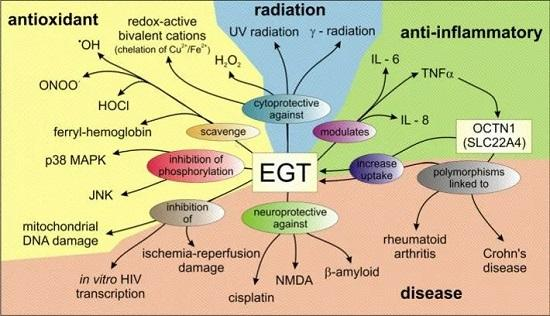
C.Anti-inflammation and other chronic diseases
Ergothioneine has been shown to inhibit the activation of NFkβ (nuclear transcription factor kβ) and the upregulation of TNF-α (tumor necrosis factor-α) caused by UVB irradiation; prevent inflammatory cells in epithelial cells mediated by TNF-α Activation and increase of factors IL-8 (interleukin-8) and IL-6 (interleukin-6); and prevents cell death caused by free fatty acids by activating p38 and JNK signaling pathways, thereby resisting inflammation and even Efficacy in Chronic Disease.
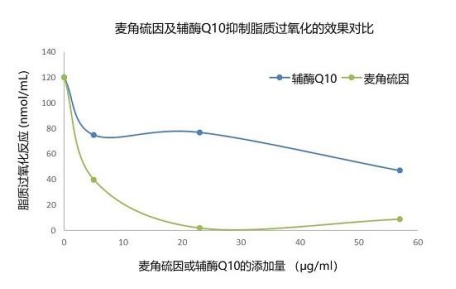
- Ergothioneine compared to other antioxidant products
A.Ergothioneine VS Coenzyme Q10
Alloxan is a strong lipid oxidant that degrades into diuric acid and then automatically oxidizes back to alloxan to generate reactive oxygen species. In the experiment, the researchers used the lipid peroxidation reaction of liposomes induced by alloxan as an indicator. PC liposomes were first treated with alloxan and then protected with ergothioneine or coenzyme Q10 to measure the degree of lipid peroxidation. Experimental results show that ergothioneine at the same molar concentration is more effective than coenzyme Q10 in resisting lipid peroxidation. The degree of lipid peroxidation treated with 4.6 μg/mL ergothioneine was reduced by 67%, while the degree of lipid peroxidation treated with 4.6 μg/mL ergothioneine was reduced by 67%. /mL Coenzyme Q10 treatment only reduced the degree of lipid peroxidation by 37%.
B.Ergothioneine VS Idebenone
To determine the direct elimination of hydrogen peroxide by ergothioneine and idebenone, the researchers added dihydrorhodamine, hydrogen peroxide, and either ergothioneine or idebenone to the culture medium. Dihydrorhodamine is oxidized by peroxide to form fluorescent rhodamine. The researchers measured the intensity of fluorescence within 120 minutes to verify the hydrogen peroxide scavenging ability of ergothioneine and idebenone. Experimental results showed that ergothioneine was more effective than idebenone in scavenging capacity at all time points tested.
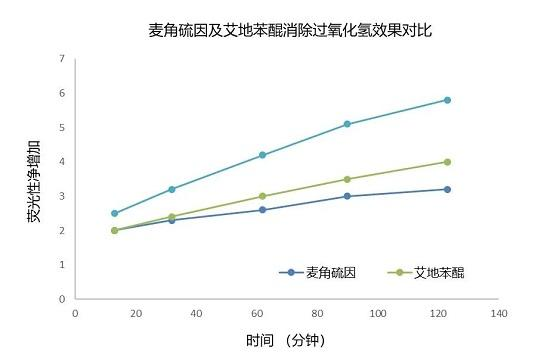
In addition to hydrogen peroxide, the researchers also used simulated ultraviolet light (UVA340) to irradiate fibroblast samples treated with ergothioneine or idebenone to compare their ability to scavenge UV-induced peroxide. The results proved that under the action of 100kJ/m2 UVA340, ergothioneine scavenged reactive oxygen species faster and more effectively than idebenone. In cells treated with ergothioneine, a decrease in reactive oxygen species levels can be observed immediately after irradiation, while the effect of idebenone on reducing reactive oxygen species levels in fibroblasts is revealed after a period of time. After one hour, idebenone reduced ROS in fibroblasts by 6.2%, while ergothioneine reduced ROS by 17.5%.
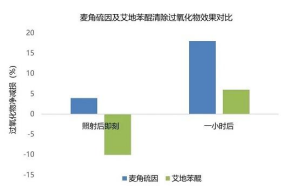
- Application cases of ergothioneine
A.Scavenging of hydroxyl radicals
The highest hydroxyl radical scavenging rate of glutathione at 0.262 mmol/L is only 22.2%, while the highest hydroxyl radical scavenging rate of ergothioneine is 64.26%. This shows that the hydroxyl free radical scavenging ability of ergothioneine is stronger than that of glutathione. And it is positively correlated with the amount added.
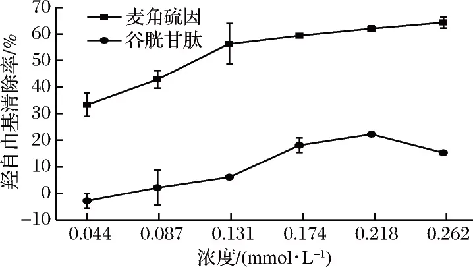
- Scavenging of DPPH free radicals
As a relatively stable free radical, DPPH free radicals can combine with single electrons of antioxidants to cause fading. The intensity of its fading is directly related to the antioxidant capacity of antioxidants.
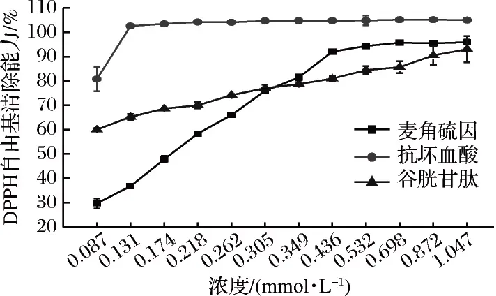
The DPPH free radical scavenging ability of ergothioneine is always between ascorbic acid and glutathione at 0.349-0.872 mmol/L, and when the concentration increases to 0.523-1.047 mmol/L, the DPPH free radical scavenging ability of ergothioneine Stable at around 96%.
- Inhibition of tyrosinase activity
As the concentration of ergothioneine increases, the ability to inhibit tyrosinase activity also increases, but whether it is the monophenolase activity inhibition pathway or the diphenolase activity inhibition pathway, ergothioneine shows good inhibitory enzyme activity. Ability, its inhibitory ability is significantly better than the positive control substance Vc of the same concentration.
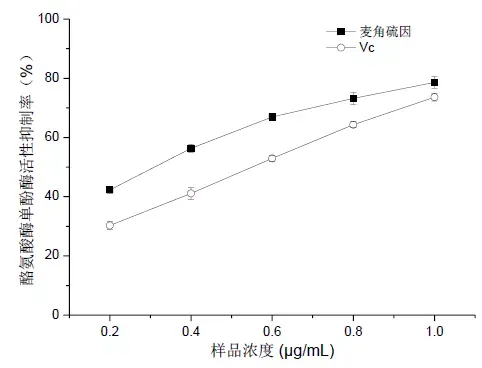
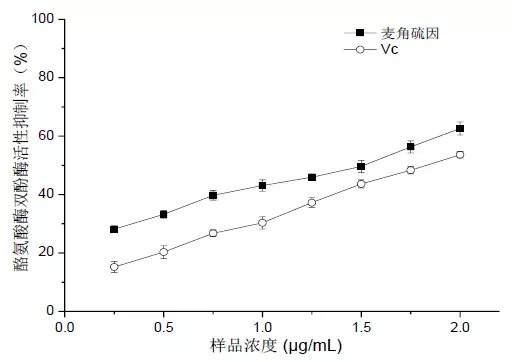
- Effect on the relative content of melanin
After the positive control kojic acid treatment for 48 hours, the production of melanin in the cells was inhibited, and the relative content of melanin was reduced, reaching 82.01% of that in the blank control group. When the concentration of ergothioneine is 0.25 mg/mL, the relative content of melanin in cells is 58.87% of that of the blank group, which is already better than the whitening effect of 25 μg/mL kojic acid.

If you have any questions about L-Ergothioneine(EGT) products or need more detailed information, our professional team is ready to support you. Please feel free to contact our customer service department:
Email: sales@sheerhherb.com
We look forward to establishing a long-term partnership with you and providing high-quality L-Ergothioneine(EGT) Powder products and personalized services.

